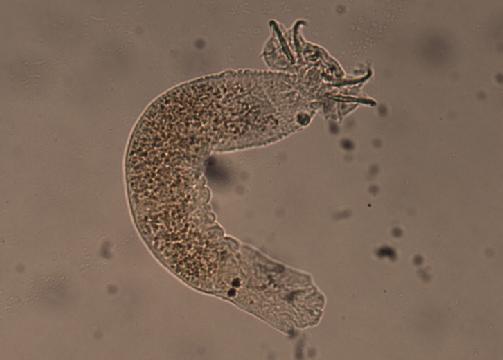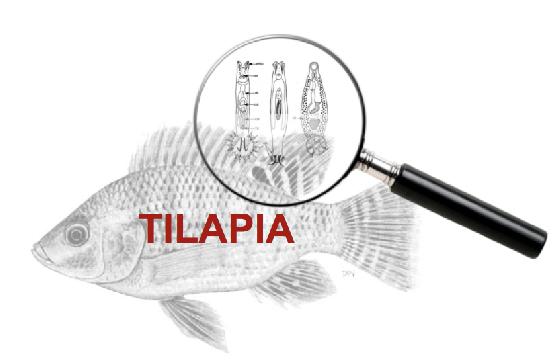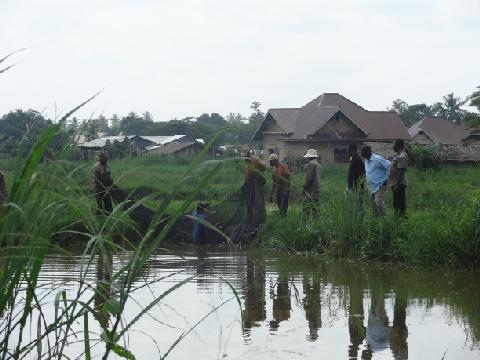Projects
TILAPIA
What can parasites tell us about fish introductions in Congo?
Project title: Tracing fish Introductions and LAteral Parasite transfer to Indigenous Aquatic fauna
We can analyse the evolutionary history of an organism by studying its parasites. Due to their shorter generation time and higher mutation rate, the parasites provide a ‘magnifying glass’ to study the host. In this project, we use this principle to study the stocking history of the Nile tilapia, a highly invasive fish species, in the Democratic Republic of Congo (DRC).
Due to their shorter generation time and higher mutation rate, parasites provide a ‘magnifying glass’ to study their host’s evolutionary history, but their potential remains underexplored in aquaculture and fisheries. The Nile tilapia, Oreochromis niloticus, is the most commonly farmed tilapia species in the world due to its fast growth and high tolerance towards environmental stressors. Native to some parts of Africa, this invasive species was introduced to every continent and has established itself in over half of the tropical countries, including the DRC. Introduction of often unknown stocks in the DRC started in colonial times for food provision, and is still ongoing. This was followed by natural and human-assisted dispersal throughout the Congo Basin. Non-native species often have negative impacts on the native fauna as they compete for food and habitat, but they can also introduce alien parasites, a crucial factor that has been mostly overlooked.
Here, we study the stocking history of the Nile tilapia in the DRC by studying their monogenean parasites. More specifically, we test whether the introduction of Nile tilapia in the Congo Basin has led to the introduction of parasite species and whether parasite genetics can help to decipher the complex fish stocking history. Parasites and their tilapia fish hosts are collected along the Congo Basin and their population genetic structure is constructed. Reference material from various African native source populations are collected through existing contacts. The unique collections of the RMCA are used to reconstruct pre-stocking conditions (before colonial times) and compare them to the present situation.
We can analyse the evolutionary history of an organism by studying its parasites. Due to their shorter generation time and higher mutation rate, the parasites provide a ‘magnifying glass’ to study the host. In this project, we use this principle to study the stocking history of the Nile tilapia, a highly invasive fish species, in the Democratic Republic of Congo (DRC).
Due to their shorter generation time and higher mutation rate, parasites provide a ‘magnifying glass’ to study their host’s evolutionary history, but their potential remains underexplored in aquaculture and fisheries. The Nile tilapia, Oreochromis niloticus, is the most commonly farmed tilapia species in the world due to its fast growth and high tolerance towards environmental stressors. Native to some parts of Africa, this invasive species was introduced to every continent and has established itself in over half of the tropical countries, including the DRC. Introduction of often unknown stocks in the DRC started in colonial times for food provision, and is still ongoing. This was followed by natural and human-assisted dispersal throughout the Congo Basin. Non-native species often have negative impacts on the native fauna as they compete for food and habitat, but they can also introduce alien parasites, a crucial factor that has been mostly overlooked.
Here, we study the stocking history of the Nile tilapia in the DRC by studying their monogenean parasites. More specifically, we test whether the introduction of Nile tilapia in the Congo Basin has led to the introduction of parasite species and whether parasite genetics can help to decipher the complex fish stocking history. Parasites and their tilapia fish hosts are collected along the Congo Basin and their population genetic structure is constructed. Reference material from various African native source populations are collected through existing contacts. The unique collections of the RMCA are used to reconstruct pre-stocking conditions (before colonial times) and compare them to the present situation.
Principal investigator:
Dates:
2014 2016Museum staff:
- Jos Snoeks
- Tine Huyse
- Maarten Vanhove
External collaborators:
Prof Antoine Pariselle, ISEM, Université de MontpellierProf Chocha Manda, Université de Lubumbashi


